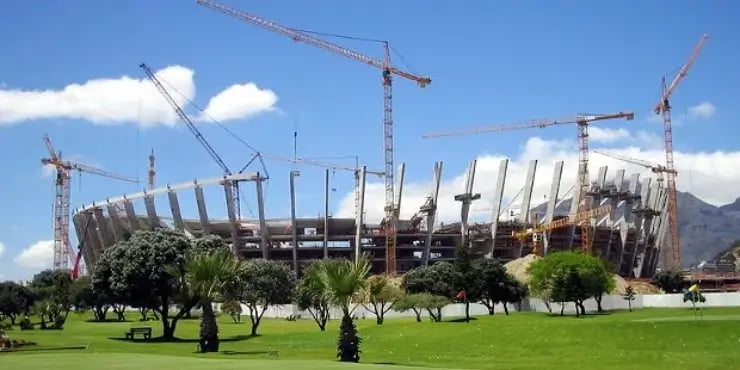Fancy pictures of green stadiums have been fast to hit the media since FIFA’s decision to give the 2022 soccer World Cup to Qatar was published. FIFA also announced that Brazil (2014), Russia (2018) and Qatar (2022) will have to satisfy green building certificate requirements when putting up new stadiums. Looking at the carbon footprint of South Africa’s 2010 World Cup, however, you learn that the stadiums only accounted for 1.1 percent of the event’s carbon footprint (0.6% for construction and renovation, 0.5% for energy use during the event). Hence, it is clear that better stadium design will only play a marginal role in the effort to significantly reduce the event’s overall emissions. But what would the effective greening of mega events look like? Is it possible at all? In this article, I analyze the carbon emissions of past events in detail, introduce you to the upcoming ones and discuss them all critically.
South Africa 2010 – The Carbon Footprint Giant
Among some of the transportation solutions mentioned in the study are the use of energy-efficient eco-taxis to ferry spectators to the games, the creation of bike and pedestrian paths to discourage the use of automobiles, and increasing the efficiency of existing public transportation options. Using vehicles that run on biodiesel or ethanol were also recommended.
The two main reasons why South Africa’s predecessor, the 2006 World Cup in Germany, was 8-times better concerning its carbon footprint, is that all the stadiums had already been built and fans did not travel as far, or as resource intensively, between cities.
Brazil, 2014 – $20 Million to be Invested in Sustainability
Russia, 2018 – World-Class High Speed Rail Network
Qatar, 2022 – A Football Nation From Scratch
If you thought building 12 open-air, air-conditioned stadiums was hard, try shipping them abroad when you’re done. And then try to explain why one of your top architects is called Albert Speer.
The 12 new stadiums will be powered by adjacent solar farms that will convert solar energy into cool air pumped into the stadiums for players and fans alike. The stadiums not only promise to be carbon-neutral, they also will be “packed up and shipped out” after the tournament has ended to provide neighboring (and less-developed) nations a world-class stadium for years to come. And since we’ve all heard how small Qatar is, traversing across the country for matches will leave an inherently small footprint.
Further Reading
- Daniela Estrada, Guardian Environment Network: World Cup 2010: Climate change fouls and goals – Green football initiatives kicking off in South Africa and Brazil clash with the countries’ overall environmental performance
Original article image by Rotsee2 (Wikimedia Commons). It shows Green Point Stadium construction, prior to the World Cup in South Africa. It is CC 3.0 BY SA and slightly edited by Moritz Bühner.
![]()





